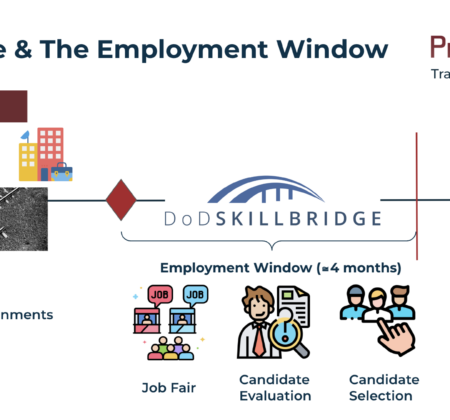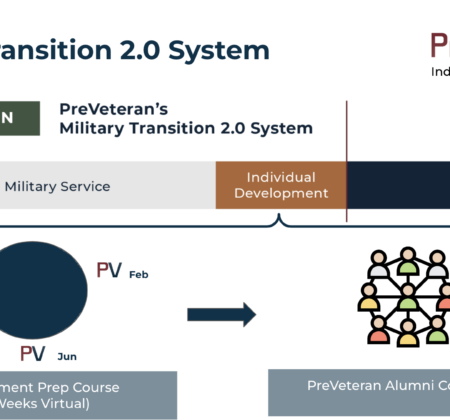Thirty years of data from studies and surveys covering military transition indicate that the vast majority—approximately 90%—of service members departing the military seek employment. Over that same period the employment breakdown has also been relatively consistent, showing approximately 60% working in the private sector and 30% staying in the public sector.
Data from that same 30-year period also indicates that transitioning military members enter a very turbulent two-year period following their transition characterized by high unemployment rates and poor employment retention when compared to our general public counterparts. On average, the transitioning military unemployment rates are two times that of the general public. For the ones who do find a job, a majority leave that first job within 12 months, which is four times faster than their general public peers. Some veteran advocates will discourage you from making a comparison between the two groups. We believe that’s a mistake for a variety of reasons.
The Need for Self-Transformation, by the Numbers…
The reasons revolve around the fact that both the military and veteran populations represent a small, increasingly shrinking portion of the overall U.S. population. For the past ten-plus years the active component, which includes the Guard and Reserve, makes up less than 1% of the population. The veteran population is a bit larger, representing 7% of the population, but each year it too is shrinking as an overall percentage of the U.S. population.
These population percentages set an important backdrop highlighting why we believe comparing these two populations is not only prudent but necessary. First, we military members are the ones who are transitioning from the military ecosystem 1% into the general population, not the other way around. We all need to get our heads wrapped around this idea because the general population, which includes employers who want to hire from our demographic, need to see us as a good hire into their companies.
Unfortunately, researchers who provide guidance to military transition policy makers seem to be advocating that the 99% population needs to twist and contort themselves to accommodate the transitioning 1% of the military. Talk about the tail attempting to wag the dog! Does it make sense that the entire U.S. population, including employers, needs to try and accommodate themselves to your needs?
Or, should it be the other way around, where those of you transitioning out of the military take responsibility for reacclimating yourselves back into the general public and private sector? At PreVeteran, we believe this approach is the right one because we understand that transitioning members have to eventually acclimate anyhow. Direct evidence of this reality are statistics that indicate that veterans begin outperforming our general public counterparts after that challenging two-year period following military transition.
With that in mind, the obvious question then becomes, if we know this is the problem, why wouldn’t we address this problem earlier? Well, that is what PreVeteran is all about! As a brand, we don’t believe we should shy away from the challenges we face. Instead, we need to acknowledge these challenges, face them head on, and make steps to overcome them.
We believe a successful military transition starts with your individual self-transformation. An important part of that self-transformation is helping those of you who want to be employees to begin aligning yourselves with the private sector well before you leave the military. This is important because the military ecosystem and private sector are very different.
The Military Ecosystem and Private Sector Are Very Different
Underlying the differences between the military ecosystem and the private sector is the realization that our military’s existence is mandated under law. The free-market private sector and companies operating in that environment are not so mandated.
Our U.S. military’s existence was codified in Article 1, Section 8, Clause 1 of the Constitution, which states the following:
“The Congress shall have power to lay and collect taxes, duties, imposts and exercises, to pay the debts and provide for the common defense and general welfare of the United States.”
In other words, our military is viewed as being essential in providing a common defense and care for the general welfare of the citizens of the United States. Taxes will fund these activities into perpetuity—absent an amendment to the Constitution.
There is no such requirement for any company, big or small, operating in the private sector. They operate exclusively in the free market where they provide a product or service that addresses their customers’ needs. Moreover, the free market is full of companies competing to address customers’ constantly changing needs and preferences. As a result, if companies are not investing, innovating, and constantly reorganizing their business to address the market demand, they will find themselves out of business.
How does this relate to you? Well, hiring talent is a huge part of the puzzle for companies. But they don’t hire just any talent—they seek exactly what they need to drive their businesses. This means businesses are looking for a very specific skill set.
Which brings up another important point—what companies don’t need. Companies don’t need a generalist, which seems to be one of the biggest frustrations on the part of transitioning military members. Military members transitioning to the private sector for employment have a lot of “soft” skills to offer such as integrity, teamwork, leadership—the list goes on. While these are important—some may even say critical—they will carry no value if you’re hired and are unable to meet the specific needs the role spelled out in the job description calls for.
There is also plenty of upside, however. If you are able to immediately contribute to business by fulfilling the specific job requirements an employer wants and then demonstrate those important soft skills while carrying out those activities, you will have the opportunity to move up quickly within the company or organization.
Alignment to the Private Sector is the Obvious Answer
At PreVeteran, we believe strongly that early alignment to the private sector will go a long way to helping you have a much more successful military transition. The rationale is pretty simple. Because the military ecosystem and the free-market private sector are so different, you need to not only be aware of the differences but also know how to demonstrate your value in a way that resonates with an employer.
On that note, alignment with the private sector is not an intellectual exercise—you can’t just learn about it in a classroom setting and make the necessary self-transformation that will make you successful. It will require having the right framework, tools, and support to not only understand this new environment from a knowledge standpoint but to also begin operating in this environment and be effective. Becoming effective leads to increased confidence and clarity of purpose. Increased confidence and clarity will lead you to successful outcomes doing what you want to do, post-transition.
We assure you that while this early alignment is critical to your success, it doesn’t take a significant amount of time if you have the right framework, tools, and support in place.
We know that military transition feels chaotic and confusing and can be completely overwhelming at times. But you don’t need to do this alone.
A good first step is to download our “5-Step Guide to Landing the Job You Want Post-Military.” While transition is a process that takes time, this will begin getting you in the right mindset to create your individual pathway to post-military transition success.
Sources:
See “Employment Situation of Veterans [for current year data],” Bureau of Labor Statistics, accessed October 30, 2020. https://www.bls.gov/news.release/vet.toc.htm
See “Interactive Constitution: Made by the National Constitution Center.” Accessed October 30, 2020. https://constitutioncenter.org/interactive-constitution/full-text


